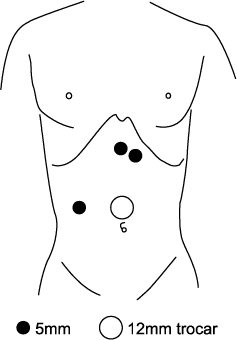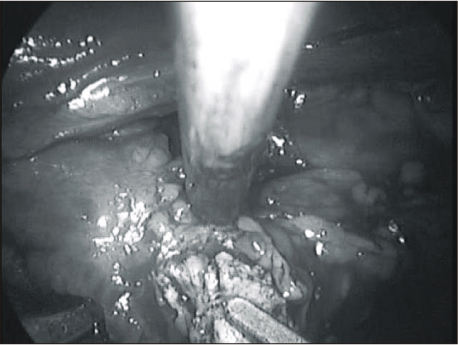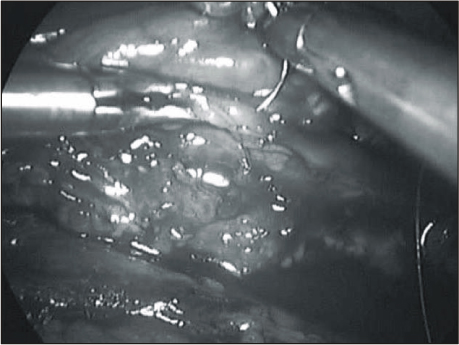Korean J Urol.
2006 May;47(5):498-501. 10.4111/kju.2006.47.5.498.
Laparoscopic Ureterolithotomy has a Role for Treating Ureteral Stones
- Affiliations
-
- 1Department of Urology, Urological Science Institute, Yonsei University College of Medicine, Seoul, Korea. khrha@yumc.yonsei.ac.kr
- KMID: 2294134
- DOI: http://doi.org/10.4111/kju.2006.47.5.498
Abstract
- PURPOSE
Shock wave lithotripsy (SWL) and ureteroscopy are used to successfully manage the majority of ureteral stones. However, some large and impacted ureteral stones still require surgery. Laparoscopic ureterolithotomy has emerged as a feasible treatment option for the patients with large and impacted ureteral stone.
MATERIALS AND METHODS
Between December 2004 and October 2005, laparoscopic ureterolithotomy was performed in 12 patients who required surgical treatment. In four patients, laparoscopy was carried as a salvage procedure after failed SWL, and laparoscopy was performed in seven patients as a primary procedure for treating large and impacted stones. The mean stone size was 16mm (range: 8-28).
RESULTS
All the procedures were completely laparoscopically, and all the patients were rendered stone-free after a single procedure; no complications were encountered. The mean operative time was 132.5 minutes (range: 60-220), and the mean estimated blood loss was 100ml (range: 50- 150). The mean postoperative hospital stay was 4.3 days (range: 2-7).
CONCLUSIONS
Laparoscopic ureterolithotomy can be a safe and effective treatment for large and impacted stones. In selected cases, it should be considered as a primary procedure for large and impacted ureteral stones that are located at the mid and upper levels of the ureter, including renal pelvic stones.
Keyword
MeSH Terms
Figure
Reference
-
1. Wolf JS Jr, Clayman RV. Percutaneous nephrostolithotomy. What is its role in 1997? Urol Clin North Am. 1997. 24:43–58.2. Hendrikx AJ, Strijbos WE, De Knijff DW, Kums JJ, Doesburg WH, Lemmens WA. Treatment for extended mid- and distal ureteral stones: SWL or ureteroscopy? Results of a multicenter study. J Endourol. 1999. 13:727–733.3. Puppo P, Ricciotti G, Bozzo W, Introini C. Primary endoscopic treatment of ureteric calculi: a review of 378 cases. Eur Urol. 1999. 36:48–52.4. Bianchi G, Malossini G, Beltrami P, Mobilio G, Giusti , Caluccio G. Renal stanghorn calculosis: our experience with the percutaneous treatment with or without extracorporeal shock wave lithotripsy. Arch Esp Urol. 1998. 51:306–309.5. Kim YW, Kim DS, Yoon DK, Cho JH. Current indications for open stone surgery in the fully equipped stone center. Korean J Urol. 1997. 38:605–608.6. Shroff S, Watson GM, Parikh A, Thomas R, Soonawalla PF, Pope A. The holmium: YAG laser for ureteric stones. Br J Urol. 1996. 78:836–839.7. Yiu MK, Liu PL, Yiu TF, Chan AY. Clinical experience with holumium: YAG laser lithotripsy of ureteral calculi. Lasers Surg Med. 1996. 19:103–106.8. Gould DL. Holmium: YAG laser and its use in the treatment of urolithiasis: our first 160 cases. J Endourol. 1998. 12:23–26.9. Robert M, Delbos O, Rakotomalala E, Drianno N, Guiter J. Piezoelectric extracorporeal lithotripsy of calculi of the median ureter (EDAP LT 02). Prog Urol. 1996. 6:539–542.10. Kupeli B, Biri H, Isen K, Onaran M, Alkibay T, Karaoglan U, et al. Treatment of ureteral stones: comparison of extracorporeal shock wave lithotripsy and endourologic alternatives. Eur Urol. 1998. 34:474–479.11. Strohmaier WL, Schubert G, Rosenkranz T, Weigl A. Comparison of extracorporeal shock wave lithotripsy and ureteroscopy in the treatment of ureteral calculi: a prospective study. Eur Urol. 1999. 36:376–379.12. Martin MA, Vilches MP, Tejero FG, Ortiz JM, Yago FP, Gomez AZ. Therapeutic options in lithiasis of lumbar ureter. Eur Urol. 2003. 43:556–563.13. Park H, Park M, Park T. Two-year experience with ureteral stones: extracorporeal shockwave lithotripsy vs. ureteroscopic manipulation. J Endourol. 1998. 12:501–504.14. Jung JW, Rha KH, Lee MS. Current indications for open stone surgery in the treatment of renal and ureteral calculi after introduction of ESWL. Korean J Urol. 2002. 43:367–371.15. O'Flynn JD. The treatment of ureteric stones: report on 1120 patients. Br J Urol. 1980. 52:436–438.16. Bishop MC, Lawrence WT, Lemberger RJ. Ureteric stone surgery in practice. Br J Urol. 1987. 59:137–141.17. Assimos DG, Boyce WH, Harrison LH, McCullough DL, Kroovand RL, Sweat KR. The role of open stone surgery since extracorporeal shock wave lithotripsy. J Urol. 1989. 142:263–267.18. Clayman RV, Kavoussi LR, Soper NJ, Dierks SM, Meretyk S, Darcy MD, et al. Laparoscopic nephrectomy: initial case report. J Urol. 1991. 146:278–282.19. Gaur DD, Agarwal DK, Purohit KC, Darshane AS, Shah BC. Retroperitoneal laparoscopic ureterolithotomy for multiple upper mid ureteral calculi. J Urol. 1994. 151:1001–1002.20. Park HK, Oh SJ, Kim HH. Laparoscopic retroperitoneal ureterolithotomy. Korean J Urol. 2002. 43:287–290.21. Flasko T, Holman E, Kovacs G, Tallai B, Toth C, Salah MA. Laparoscopic ureterolithotomy: the method of choice in selected cases. J Laparoendosc Adv Surg Tech A. 2005. 15:149–152.
- Full Text Links
- Actions
-
Cited
- CITED
-
- Close
- Share
- Similar articles
-
- Laparoscopic Retroperitoneal Ureterolithotomy
- Efficacy of Laparoscopic Ureterolithotomy for the Upper Ureter Stone
- The Risk Factors of Ureteral Stricture after Treatment for Ureteral Calculi
- Video Assisted Minilaparo-Ureterolithotomy in 36 Upper Ureteral Calculi
- The Outcome of Laparoscopic Retroperitoneal Ureterolithotomy for the Management of Upper Ureteral Stones Larger than 10 mm: A Comparison with Rigid Ureteroscopic Removal of Stones with Lithoclast(R)




